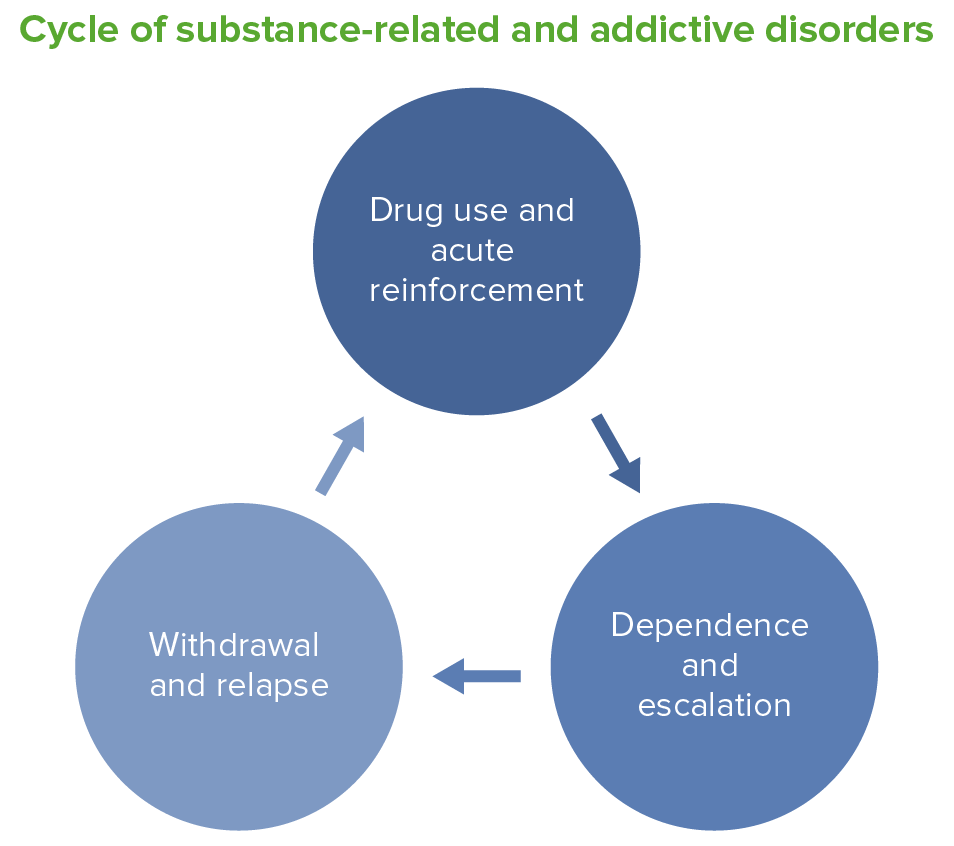Playlist
Show Playlist
Hide Playlist
Amphetamines – Drugs of Abuse
-
Slides DrugsOfAbuse Toxicology1.pdf
-
Download Lecture Overview
00:01 Amphetamines are very commonly abused in society today. 00:05 We have dextroamphetamines, methamphetamines and crystal methamphetamine which is very commonly abused in the United States and around the world. 00:15 Amphetamine alters the transport of CNS amines like dopamine, norepinephrine and serotonin. 00:25 Initially, amphetamines cause euphoria. People feel great. They feel self-confident. They feel particularly alert. 00:32 And it becomes a very very addictive kind of sensation. 00:36 Overdose includes restlessness, agitation, tachycardia, hyperthermia, hyperreflexia and seizures. 00:43 And long term chronic use results in psychosis including delusions and paranoia. 00:49 And one of the most worrisome thing that we started to see now, particularly with crystal meth, is necrotizing arteritis cerebral hemorrhage and renal failure. 01:01 There are other types of cogeners of amphetamines which are making the marketplace particularly crowded. 01:09 There is DOM, also known on the street as STP. 01:13 Now, this drug was first invented in 1963 by a chemist by the name of Alexander Shulgin. 01:20 He actually gave away a whole bunch of STP in 1967 in Haight Ashbury district of San Francisco. 01:28 What ended up happening was all these people showed up in emergency departments with this very bizzare kind of syndrome and it took us a long time to figure out what it was. This drug has a very long duration. 01:41 It causes pupillary dilatation, hypertension, increased sexual drive and hallucinations. 01:48 One of the most common new cogener of amphetamine is MDMA or ecstasy. 01:55 Now, we're starting to get into a new class of drugs that are locally called designer drugs. 02:01 MDMA or ecstasy is more selective on serotonin than regular amphetamines. 02:08 Users think that it facilitates interpersonal communication. People feel like they can talk forever when they take this drug. 02:15 They feel like they're warm and fuzzy towards each other. And it's often used as a sexual enhancer. 02:20 PET scans show a reduction of neuron function in serotonergic tracts even with low dose occasional use. 02:29 So, it does alter brain function even when patients aren't taking the medication and we do find that there are some long term side effects. Overdose of this medication, you'll often see that ecstasy burn when patients come in, and they are hyperthermic, they have a serotonin syndrome kind of complex and they come in with seizures. So, often you'll see people, and the typical story is a raver, a person who went to a rave party, where there is lots of drugs, and they've taken ecstasy, and now they are hyperthermic and they are starting to have seizures. 03:00 Withdrawal. Prolonged depression is very common. 03:03 I think a lot of depression in young people is from chronic low intensity ecstasy use. 03:11 Here's a positron emission tomography scan of a patient who uses MDMA. 03:16 What's amazing about this particular scan is that this person was not taking MDMA at the time of the scan. 03:22 The last dose had only been two or three days prior. 03:28 Another cogener of amphetamine is MDA. It's an empathogen. And so, what patients tend to feel when they take this drug is more empathetic, more hyperemotional. This is known as "Sally" or "sass" or "sass-a-frass" on the streets. 03:47 It is a serotonin reuptake inhibitor and it releases serotonin. It is seven times more potent than ecstasy on the 5-HT receptor which is why we think it is such as an emotive kind of a drug. It is more psychedelic than MDMA as well. 04:04 And it is also more stimulating in terms of alertness and activity.
About the Lecture
The lecture Amphetamines – Drugs of Abuse by Pravin Shukle, MD is from the course Toxicology.
Included Quiz Questions
What is ecstasy?
- 3-4 methylenedioxymethamphetamine (MDMA)
- 2,5-Dimethoxy-4-methylamphetamine (DOM)
- 3,4-Methylenedioxyamphetamine (MDA)
- Crystal methamphetamine
- None of the options provided
Which set of clinical manifestations is most likely caused by 3-4 methylenedioxymethamphetamine (MDMA) toxicity?
- Hyperthermia, psychomotor agitation, and seizures
- Hyperthermia, hypotension, and somnolence
- Hypothermia, hypertension, and somnolence
- Hypothermia, hypotension, and psychomotor agitation
- Hypothermia, psychomotor agitation, and seizures
What is the mechanism of action of methylenedioxyamphetamine (MDA)?
- Serotonin reuptake inhibitor and releasing agent
- Dopamine reuptake enhancer and blocking agent
- Serotonin reuptake enhancer
- Norepinephrine releasing inhibitor
- Norepinephrine antagonist
Customer reviews
5,0 of 5 stars
| 5 Stars |
|
5 |
| 4 Stars |
|
0 |
| 3 Stars |
|
0 |
| 2 Stars |
|
0 |
| 1 Star |
|
0 |





